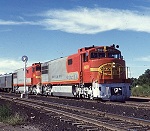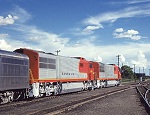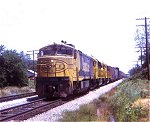A General History |
|---|
 |
In the mid-60's, before the Post Office cancelled its railroad mail-hauling
contracts and sent passenger train profitability plummeting, Santa Fe began to order new
second-generation passenger power to replace aging first-generation units. Ten General Electric
U28CG's were delivered in 1966, basically standard hood-unit U28C's with a steam generator installed in
the room provided for that purpose behind the cab on all GE Universal-series locomotives. Desiring
something more streamlined on the point of its passenger trains, Santa Fe next took delivery of six
cowl-bodied U30CG's numbered 400-405 from GE in late 1967. Inside, the units were standard U30C's with a
steam generator, but outside, the short rounded nose and fluted carbody were like nothing
seen on the rails before or since.
Even when new, the big GE's almost never showed up on Santa Fe's premier, extra fare
transcontinental passenger trains. Instead, they were assigned to power the Texas
Chief, the Grand Canyon, and the Tulsan, as well as various
secondary Texas trains. In the summer of 1968, Steve Gillings photographed what is believed to be
Tr. 24, the remains of the eastbound Grand Canyon, heading past the roundhouse at Belen, NM behind U30CG's
400 and 404. The train would turn on the wye at the east end of the yard, then head north to Albuquerque. From September 1968 until February 1969, the big GE's also worked
the San Diegan schedules as part of a power pool between that train and the Grand
Canyon. |
 |
 |
The tracking characteristics of the big GE's at passenger speeds were called into question
following the derailment of U28CG-powered Tr.23 near Chillicothe, IL on February 9,
1969. Tests were conducted the following month, and in the meantime, the U28's and U30's were
reassigned to freight duties. The units saw extensive use on Santa Fe's premiere 79 mph hotshot piggyback
train, the Super C but Karl Rethwisch found U30CG 404 and U28CG 356 on a lowly manifest at Streator, IL in 1969. The GE's showed no particular propensity for leaving the rails in freight service, and began returning to the point of the Texas Chief and the Tulsan
in the second half of 1969. Their brief careers as passenger units, though, were almost over.
|
 |
The U30CG's were renumbered to the 8000-series in April 1970 as part of the 1969/70 general
renumbering, and in the remaining 12 months before Amtrak, they were seldom seen on passenger
trains. The photo at left shows passenger-painted 8005 on a manifest in May 1970.
(R.R. Wallin photo, Bill Weibel collection)
|
 |
Following Amtrak's takeover of Santa Fe's remaining passenger service in May 1971, the
U30CG's were gradually repainted into freight colors. Two of the units, 8000 and 8004,
received the old blue and yellow pinstripe freight scheme worn by the F45's before Santa Fe
adopted the blue and yellow warbonnet scheme in 1972. At least one unit, 8002, lasted in red and silver into
1973. When the U30CG's were first painted in blue and yellow warbonnet, they received huge,
"hollow" nosebands similar to the ones they wore in the red and silver scheme (see 8003 above
and 8005 at left). Randy J. Williams recorded the view of 8003 at Ft. Madision, IA in September 1979 and 8005 westbound at Galesburg, IL in August 1973.
|
 |
The use of U28 and U30CG's on the Super C didn't last long into the
1970's. They were assigned to the general Kansas City - Chicago freight pool, keeping them
close to the maintenance base at the Argentine Shops in Kansas City. Over the course of the
decade, U30CG's did turn up on trains running further west into Kansas, south into Texas, and occasionally
all the way west to California. Power shortages in the late 70's and 1980, in particular, found the
former passenger GE's straying west with greater frequency. |
 |
The first coat of freight paint applied to several of the passenger GE's didn't adhere very well to the old layer of paint underneath it. U30CG 8001 was already shedding yellow by late 1973, and by the time Bruce Black found it at Denver, CO in April 1977, the passenger red and silver scheme was well on its way to re-emerging. The unit mercifully got a fresh coat of blue and yellow four months later. |
 |
Jim Bartolotta caught U28CG 7904 and U30CG 8001 well outside their usual territory on a westbound at
Barstow, CA in May 1978. The 7904 was the first GE locomotive to receive the blue and yellow warbonnet scheme in July 1972, and by 1978 it was falling victim to paint cancer. Recently repainted 8001, by contrast, looks great in the updated freight scheme with a small, solid blue noseband and blue stepwells. The 8002 and 8005, at least, were similarly repainted. The 7904 would also receive a fresh coat of blue and yellow with blue stepwells before it was retired. |
 |
Lorne A. Noyes found the 8001 leading a westbound west of Flagstaff, AZ in early
1980. Compare the solid blue, hood-unit size noseband with the "hollow" band modeled by 8003 and 8005 in
previous photos. |
 |
 |
As was the case with most of Santa Fe's U-boats, the U30CG's didn't manage to outlive
their financing. After 13 years of service, all six U30CG's were retired in September 1980. Along with
the 10 U28CG's, they were traded in to GE for 16 B36-7's and scrapped. Frank Novak captured U30CG 8004, U28CG 7903, and another U30CG dead-in-transit on a Conrail train rolling east through Collinwood Yard in Cleveland, OH in 1981. |



